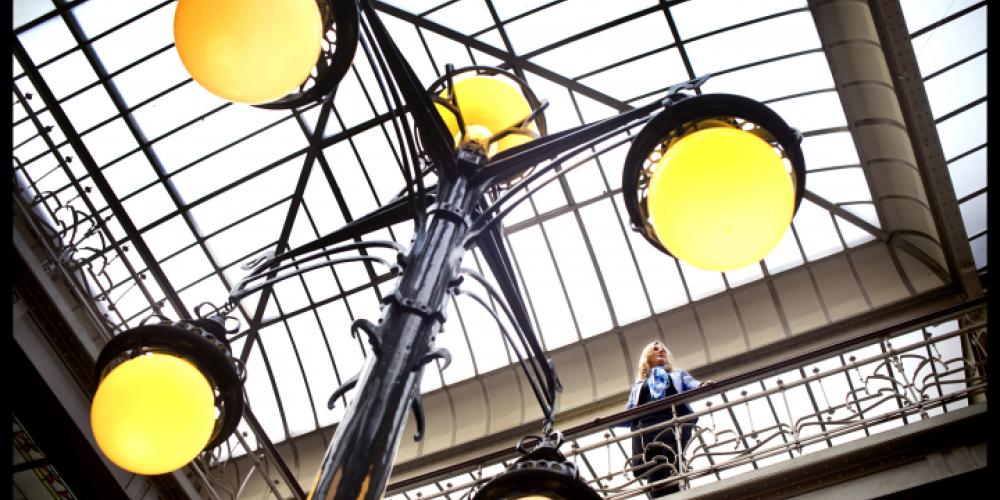
Smolders chose the Belgian Comic Strip Centre, or Stripmuseum, on Zandstraat as a meeting place. An earlier suggestion of visiting a couple of houses near one another in Elsene and Sint-Gillis, such as Hotel Tassel in Paul Emile Jansonstraat, Paul Hankar’s house in Defacqzstraat or the house at 92 Afrikaansestraat, seemed impractical. These houses are still in private ownership and not freely accessible to the public. This should come as no surprise, because Art Nouveau is, with few exceptions, an extremely middle-class style. Therefore museums open to the public, such as the Horta Museum, stand sentinel over their heritage. “I wanted to have our wedding photographs taken in the Horta Museum. It wasn’t impossible, but the price they were asking was extremely steep. In the end we just had our photos taken outside in the Grote Markt in the centre of Brussels.
The Stripmuseum was designed by Victor Horta, the most significant representative of this architectural genre in Belgium, who was also, at that time, a ULB professor. It is a building that Smolders knows well. “My husband enjoys reading comic strips and from time to time we come to exhibitions here. In September 2010 we, along with our research team, organised the closing dinner here for the international conference on in vivo methods for the International Society for Monitoring Molecules in Neuroscience. And, moments definitely not easily forgotten: some of the galas of my student days took place here.”
“What I find so splendid about this architectural style is its gracefulness: it’s sometimes called the ‘spaghetti style’ or the ‘whip style’. When you look at the wrought iron banisters or the ceiling paintings in the Hotel Tassel, or the sinuous door handles on the front door of the Horta Museum, or the wallpaper and the dome there: the lines are simply so beautiful, I really appreciate them. It has been said that Art Nouveau inspires an optimistic view of the world, with a deep-rooted faith in the future: so if you were to be sufficiently immersed in such beauty, everything would automatically fall into place for you. I’d really like to believe that.”
“It’s the considered nature of the style that attracts me – and my scholarly side. Nothing is left to chance. Art Nouveau is a Gesamtkunstwerk, an all-embracing art form. Everything is in harmony: the house, the cabinets, the beds, the chairs, the lamps, the vases, the cutlery, the crockery, the wall decorations, …”
“It has been said that Art Nouveau inspires an optimistic view of the world. I’d really like to believe that.”
Meanwhile we are walking up and down the stairs of the Stripmuseum. Ilse Smolders tells me that the building dates from 1903 and used to be a warehouse, the ‘Waucquez Warehouses’. She draws the attention to various decorative elements that she finds charming.
“Art nouveau is inspired by nature: flower and plant motifs recur frequently. That appeals to me, because I also love nature. The use of wrought iron you can observe here is fairly unique. Wrought iron isn’t only used as a functional element but it’s also on display. This leads to another important feature: the light that is created! It was groundbreaking at that time – especially in private houses. It’s a world away from dark houses with small windows! There was much emphasis on the division of space, the difference between floors, the huge glass screens and distinctive windows. A stairwell topped with a glazed cupola that could transform a house into an oasis of light. Victor Horta was a master at creating a sense of space in a middle-class house – in those days it was unprecedented!”
“I find it critical that a house should be full of light. My own home has windows everywhere, from floor to ceiling. It’s just fantastic to have all that light coming in!”
“It’s a great shame that the Art Nouveau houses are so spread out across Brussels that you’d have trouble visiting them all in a day. Even if you had the whole weekend, you’d still have to set a cracking pace to manage to see them all! Sometimes we take our children in the car and drive around Brussels, enjoying all the beautiful Art Nouveau façades. In my wildest dreams for Brussels all these houses would be beside each other in an ‘Art Nouveau district’. Imagine 150-160 beautiful houses, each a short walk from the other: we’d become an unbeatable city-trip destination!”
“In my wildest dreams for Brussels all these houses would be beside each other in an ‘Art Nouveau district’”
Smolders tells me that she also travels to other countries to seek out architecture from the same period. A trip to Porto and Aveiro in Portugal is marked on her calendar for this summer; also on the agenda is “the most beautiful bookshop in the world”, the Livraria Lello & Irmão. “Especially for my daughters, because they love books so much.”
So, does she also dream of living in an Art Nouveau house? A degree of hesitancy enters her voice. “The houses are, of course, appallingly expensive, and many are protected – so renovation would cost the earth. To be honest, I don’t really know if I could live in a house like that, maybe it would quickly become too demanding. I live in a new build with stark lines and huge windows. After a busy day at work I come home to relax … so Art Nouveau is more of an inspiration.”